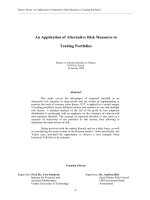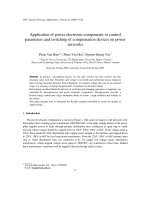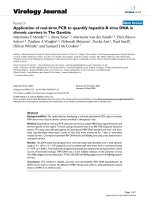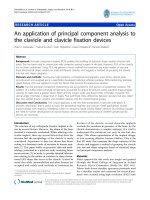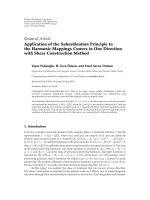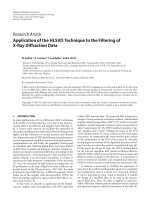Application of Marker Assisted Backcrossing to Pyramid Salinity Tolerance (Saltol) into Rice Cultivar- Bac Thom 7
Bạn đang xem bản rút gọn của tài liệu. Xem và tải ngay bản đầy đủ của tài liệu tại đây (845.69 KB, 13 trang )
VNU Journal of Science, Natural Sciences and Technology 28 (2012) 87-99
87
Application of Marker Assisted Backcrossing to Pyramid
Salinity Tolerance (Saltol) into Rice Cultivar- Bac Thom 7
Le Hung Linh
1,
*, Tran Dang Khanh
1
, Nguyen Van Luan
1
, Dong Thi Kim Cuc
1
,
Le Duy Duc
1
, Ta Hong Linh
2
, Abdelbagi M Ismail
3
, Le Huy Ham
1
1
Agricultural Genetics Institute, Pham Van Dong, Hanoi, Vietnam
2
Vietnam Academy of Agricultural Sciences, Thanh Tri, Hanoi, Vietnam
3
International Rice Research Institute, DAPO Box 7777, Metro Manila, Philippines
Received 13 January 2012
Abstract. Vietnam is one of the most vulnerable countries to climate change in Asia. Rice is a
principle food in Vietnam and plays an important role in economy of the country. However, rice
yield and its cultivating areas are adversely affected from the threats of devastation caused by the
rise of sea level. Using marker assisted backcrossing (MABC) to develop a new salt tolerance rice
variety is one of the feasible methods to cope with these devastating changes. To improve rice salt
tolerance in Bac Thom 7 cultivar, FL478 was used as a donor parent to introgress the saltol QTL
conferring salt tolerance into Bac Thom 7. Three backcrosses were conducted to transfer positive
alleles of saltol from FL478 into Bac Thom 7. The plants number IL-30 and IL-32 in BC
3
F
1
population expected recurrent genome recovery of up to 99.2%, 100%, respectively. These
selected lines that carried the saltol alleles were screened in field for their agronomic traits. All
improved lines had saltol allele similar to the donor parent FL478, whereas their agronomic
performances were the same as the original Bac Thom 7. We show here the success of improving
rice salt tolerance by MABC and the high efficiency of selection in early generations. In the
present study, MABC accelerated the development of superior qualities in the genetic background
of Bac Thom 7.
Keywords: Background selection, marker assisted backcross, rice, QTL.
1. Introduction
∗
∗∗
∗
Salinity is one of the major impediments to
enhancing production in rice growing areas
worldwide. One-fifth of irrigated arable lands in
the world have been reported to adversely
influence by high soil salinity [1]. As the report
_______
∗
Corresponding author. Tel: 84-4-37544712.
E-mail:
of FAO, (2010) [2], over 800 million ha of
worldwide land are severely salt affected and
approximately 20% of irrigated areas (about 45
million ha) are estimated to suffer from
salinization problems by various degrees. This
is more serious since irrigated areas are
responsible for one third of world`s food
production. In Asia, 21.5 million hectares of
land areas is affected by salinity and estimated
L.H. Linh et al. / VNU Journal of Science, Natural Sciences and Technology 28 (2012) 87-99
88
to cause the loss of up to 50% fertile land by the
21
st
mid-century [3].
Rice is the most important food crop for
over half of the world’s population and supplies
20% of daily calories [4]. Rice is a major crop
in Vietnam, as the world's second-largest rice
exporter after Thailand, and together accounting
for 50% of the world rice trade. Vast portions
of the food producing regions in the country
will be inundated by sea water, expected at
about 19.0%̶-37.8% of the Mekong River Delta
(MRD) and about 1.5% -11.2% of the Red
River Delta (RRD). With sea level rise by 1 m,
approximately 40,000 km2 will be inundated,
and salinity intrusion is expected to cover about
71% of the MRD and RRD, together with other
coastal regions. The economic loss by salt
intrusion in 2005 was up 45 million USD,
which is equivalent of 1.5% of annual rice
productivity in the Mekong Delta [5]. It has a
salinity threshold of 3 dS/m, with a 12%
reduction in yield per dS/m, beyond this
threshold. Therefore, rice yields can be reduced
by up to 50% when grown under moderate (6
dS/m) salinity levels [6]. The crop yield
reduction in salt soils can be overcome by soil
reclamation or by improving salt tolerance in
target crops. Therefore, the need for
enhancement in salt tolerance in rice is well
understood. In the last ten years, a rapid
progress have been made towards the
development of molecular marker technologies
and their application in linkage mapping
molecular dissection of the complex
agronomical traits and marker assisted breeding
[7].
Rice cultivars grown in saline soil are
sensitive at both the vegetative and
reproduction stages. However, salinity tolerance
at different growth stages seems to be managed
by independent genes. Saltol is a major
quantitative trait locus (QTL) and was
identified in the salt-tolerant cultivar Pokkali.
Its location was detected on chromosome 1.
This QTL confers salinity tolerance at the
vegetative stage and explains from 64% to 80%
of the phenotypic variance [8]. Several studies
reported this QTL was detected in some other
rice varieties [9, 6]
The basis of MABC strategy is to transfer a
specific allele at the target locus from a donor
line to a recipient line while selecting against
donor introgressions across the rest of the
genome [10]. The use of molecular markers,
which permit the genetic dissection of the
progeny at each generation, increases the speed
of the selection process, thus increasing genetic
gain per unit time [11]. The main advantages of
MABC are: (1) efficient foreground selection
for the target locus, (2) efficient background
selection for the recurrent parent genome, (3)
minimization of linkage drag surrounding the
locus being introgressed, and (4) rapid breeding
of new genotypes with favorable traits. The
effectiveness of MABC depends on the
availability of closely linked markers and/or
franking markers for the target locus, the size of
the population, the number of backcrosses and
the position and number of markers for
background selection [12]. MABC has
previously been used in rice breeding to
incorporate the bacterial blight resistance gene
Xa21 [13, 14] and waxy gene [15] into elite
cultivars. The availability of the large-effect
QTL Saltol for salinity tolerance in rice, a
theoretical frame-work for MABC and the
existence of intolerant varieties that are widely
accepted by farmers provided an opportunity to
develop cultivars that would be suitable for
larger areas of submergence prone rice [16].
The main objective of our study was to develop
a salinity-tolerant version of the widely grown
L.H. Linh et al. / VNU Journal of Science, Natural Sciences and Technology 28 (2012) 87-99
89
Bac Thom 7 by applying the MABC method.
The improved cultivar may be useful for
growing in the soil salinity of the coastal areas
of Vietnamese Deltas.
2. Materials and Methods
2.1. Plant materials and crossing scheme
The scheme for constructing the plant
materials used in this study is summarized in
Figure 1. A highly salt tolerant FL478 (IR
66946-3R-178-1-1) was used as the donor of
Saltol QTLs, whereas Bac Thom 7 (O. sativa
spp. indica), a popular growing Vietnamese
elite cultivar with high quality was used as the
recipient parent. A total 477 SSR markers
distributed in the 12 chromosomes including
foreground, recombinant and background
markers were screened. For the MABC scheme,
Bac Thom 7 was crossed with FL478 to obtain
F1 seeds (Fig. 1). F1s were backcrossed with
Bac Thom 7 to obtain a large number of BC
1
F
1
seeds. In the BC
1
F
1
generation, individual plants
that were heterozygous at the Saltol locus were
identified reducing the population size for
further screening (foreground selection). From
the individual plants that were heterozygous for
Saltol, those that were homozygous for the
recipient allele at one marker locus (RM10825)
distally franking the Saltol locus (i.e.
recombinant) were identified. We termed this as
“recombinant selection” [17]. Some used
markers in detail are shown in Table 1. From
these recombinant plants, individuals with the
fewest number of markers from the donor
genome were selected (background selection).
In the second and third BC generations, the
same strategy was followed for selection of
individual plants with the desired allele
combination at the target loci including
selection for recombinants between Saltol and
the nearest proximal marker locus (RM10694)
and suitable genomic composition at the non-
target loci and crossed with the recipient parent
to develop the next generation. The selected
BC2 and BC3 plants were self-pollinated for
further analyses.
2.2. Molecular marker analysis
DNA was extracted from juvenile leaves of
2-week-old plants using a modified protocol as
described by Zheng et al. (1995) [18]. PCR was
performed in 10 µl reactions containing 5–25
ng of DNA template, 1 µl 10 X TB buffer
(containing 200 mM Tris–HCl pH 8.3, 500 mM
KCl, 15 mM MgCl
2
), 1 µl of 1 mM dNTP, 0.50
µl each of 5 µM forward and reverse primers
and 0.25 µl of Taq DNA polymerase (4 U/ µl)
using an MJ
Research single or dual 96-well thermal
cycler. After initial denaturation for 5 min at
94°C, each cycle comprised 1 min denaturation
at 94°C, 1 min annealing at 55°C, and 2 min
extension at 72°C with a final extension for 5
min at 72°C at the end of 35 cycles. The PCR
products were mixed with bromophenol blue
gel loading dye and were analyzed by
electrophoresis on 8% polyacrylamide gel using
mini vertical polyacrylamide gels for high
throughput manual genotyping (CBS Scientific
Co. Inc., CA, USA). The gels were stained in
0.5 mg/ml ethidium bromide and were
documented using Alpha Imager 1220 (Alpha
Innotech, CA, USA). Microsatellite or Simple
sequence repeat (SSR) markers were used for
selection [19].
L.H. Linh et al. / VNU Journal of Science, Natural Sciences and Technology 28 (2012) 87-99
90
Figure 1. The scheme of applying MABC to improve salt tolerance in Bac Thom 7 cultivar.
Table 1. Details of markers for foreground and recombinant selection
L.H. Linh et al. / VNU Journal of Science, Natural Sciences and Technology 28 (2012) 87-99
91
2.3. Foreground and recombinant selection
At the initial stages of the experiment, for
selection of the Saltol locus (foreground), the
reported rice microsatellite (RM) markers
RM493 and RM3412b, which were found to be
tightly linked to Saltol was used for foreground
selection. For franking markers used for
recombinant selection, about 5 Mb region of the
Saltol region was targeted. Four polymophic
microsatellite markers (RM1287, RM10694,
RM562, RM7075) were identified for
recombinant selection (Table 1, Fig. 2).
2.4. Background selection
Microsatellite markers unlinked to Saltol
covering all the chromosomes including the
Saltol carrier chromosome 1, that were
polymorphic between the two parents, were
used for background selection to recover the
recipient genome (Fig. 3). Based on the
polymorphic information, initially evenly
spaced microsatellite markers were selected per
chromosome. At least four polymorphic
microsatellite markers per chromosome were
used. The microsatellite markers that revealed
fixed (homozygous) alleles at nontarget loci at
one generation were not screened at the next
BC generation. Only those markers that were
not fixed for the recurrent parent allele were
analyzed in the following generations. For the
selected plants from BC
2
F
1
and BC
3
F
1
, an
additional 84 microsatellite markers were used
to check the fixation of the recipient genome.
2.5. Screening for agronomic traits
The BC
3
F
1
plants with the parents, Bac
Thom 7 and FL478 were grown in a field at the
Thanh Tri, Hanoi, Vietnam. The plants were
laid in a 20 x 15 cm distance and evaluated for
12 traits: 1) Days to heading (dth) were
evaluated as the number of days from sowing
until the panicle headed; 2) Plant height (ph)
was measured in centimeters from the soil
surface to the tip of the tallest panicle (awns
excluded); 3) Panicle length (pl) was measured
in centimeters from the neck to the panicle tip;
4) Panicle number (pn) was calculated as the
number of panicles per plant; 5) 1,000 seed
weight (tsw) was measured in grams as the
weight of 1,000 fully filled seeds per plant; 6)
Primary branch number (pb) was estimated as
the number of primary branches per panicle; 7)
Secondary branch number (sb) was estimated as
the number of secondary branch per panicle; 8)
Seed per panicle (sp) was calculated as the
number of fully filled seed per panicle; 9)
Spikelets per panicle (spp) were calculated as
the number of spikelets per panicle.
2.6. Statistical analyses
The molecular weights of the different
alleles were calculated by Alpha Ease Fc 5.0
software. The marker data was analyzed using
the software Graphical Genotyper [20]. The
homozygous recipient allele, homozygous
dominant allele and heterozygous allele were
scored as ‘A’, ‘B’ and ‘H’, respectively. The
percent markers homozygous for recipient
parent (%A) and the percent recipient alleles
including heterozygous plants (%R) were
calculated. All experimental analyses of the
agronomic traits were performed in a
completely randomized design with at least
thrice. Data were analyzed with the use of the
Duncan’s multiple-range test (P<0.05).
L.H. Linh et al. / VNU Journal of Science, Natural Sciences and Technology 28 (2012) 87-99
92
3. Results
3.1. Foreground and recombinant selections
As the obtained result from screening of 30
SSR markers at the target region on
chromosome 1 for polymorphic markers, ten
markers showed pholymorphics between the
parents. Two markers, namely RM493 and
RM3412b tightly linked to Saltol and four
markers RM1287 RM562, RM3252, RM490
were detected for foreground and recombinant
selection, respectively. In each backcross
generation (BC
1
F
1
- BC
3
F
1
), the target locus
Saltol was monitored by markers linked to the
Saltol genes. Individual BCnF
1
plants were first
selected based on the heterozygous nature of all
the target loci at Saltol region. Only a few such
selected individuals that had the least donor
alleles of the background markers were chosen
to be backcrossed with Bac Thom 7. In
advanced backcrosses and selfed generations,
marker polymorphic RM493 and RM3412b
tightly linked with Saltol was used to screen .
Four polymorphic markers between Bac
Thom 7 and FL478 at target region were used
to screen individual BC
1
F
1
plants. In
conjunction with background section, the Saltol
carrier chromosome 1 of a few selected
individuals, including plants number 1, 7, 8 and
26 in BC
2
F
1
, whereas, the plants numbers 10,
14, 30, 41, 359 in BC
3
F
1
was characterized with
two markers for foreground selection (RM493
and RM3412b). When the selected plants of
BC
3
F
1
(plants number. 10, 30, 32 and 359) were
screened with these two markers, the alleles of
markers from RM3412 (12597139bp) through
RM493 (13376867bp) were of the donor
(FL478) type, and the alleles of all the
remaining markers from RM1287 (11836436
bp) to RM562 (16232926 bp) onwards were of
Bac Thom 7, indicating that these plants were
single recombinants.
3.2. Background selection
A total of 477 SSR markers were screened
for polymorphism between Bac Thom 7 and
FL478. Among them, 89 (18.7 %) markers
showed polymorphisms on 4 % polyacrylamide
between the parents. The 89 polymorphic
markers were used to background selection.
The results for polymorphism by SSR marker
analysis are diagrammed in Figure 3. Eighty
nine polymorphic markers between the parents
distributed on chromosome 1 (twelve), 2, 11
(seven), 3 (ten) 4, 10, 12 (five), 5, 6 (four), 7, 9
(eight), 8 (six), respectively (Fig. 3). In BC
1
F
1
,
A total of 30 microsatellite markers were used
for background selection in 25 BC
1
F
1
plants
resulting from foreground and recombinant
selection (Figs. 1, 2). Based on the foreground
and background selection, two selected BC
1
F1
plants (Nos. 7 and 13) were developed BC
2
F
1
populations. In the BC
2
F
1
population, 43
polymorphic markers were used for background
selection in 19 BC
2
F
1
plants resulting from
foreground and recombinant selection plants
No. 21, 41. For plant No. 21, chromosomes 5,
and 8 were of complete recipient types. In this
experiment, the background analysis of BC
3
F
1
revealed the recurrent genome recovery of up to
100% at which individual lines were ranging
from 81% to 100% as shown in Fig. 4. The
recurrent genome recovered in the plants No.s
IL-30, IL-32 is expected to be 99.2% and
100% , respectively (Fig. 4).
L.H. Linh et al. / VNU Journal of Science, Natural Sciences and Technology 28 (2012) 87-99
93
Figure 2. Graphical representation of the regions on chromosome 1containing Saltol.
White portions of the bar = homozygous
Bac Thom segment, black regions =
homozygous Saltol segment, and diagonal
slashes = regions where crossing over occurred.
Markers polymorphic between Bac Thom and
FL478 are label on both sides of the
chromosome. The estimated distances in kb
between the SSR markers and their orders are
available at www.gramene.org [21]
Table 2 shows the agronomic traits in field
screening of the IL to compare with the Bac
Thom 7. In general, there is no significant
difference beween the morphological traits of
IL and Bac Thom 7. However, the plant height
(PH) of IL-30 and IL-32 was 4–5 cm higher
than that of Bac Thom 7. The agronomic traits
including day to heading (DTH), and
secondary plant number (SP) were similar to
those of the recurrent parent, Bac Thom 7
(Table 2). Moreover, The other traits such as
panicle length (PL), panicle number (PN),
primary plant number (PN), seed per panicle
(SP), Spikelets per panicle (spp) and grain
yield, 1000-grain weight of the selected two
lines were almost the same as those of Bac
Thom 7. (Table 2).
L.H. Linh et al. / VNU Journal of Science, Natural Sciences and Technology 28 (2012) 87-99
94
Figure 3. Graphical representation of mapping. Chromosome numbers are at the top of the bars. White portions
of the bars are derived from Bac Thom 7 and dark regions with the SSR markers linkage the Saltol. Markers
polymorphics between Bac Thom 7 and FL478 are labeled on the left of the chromosomes.
L.H. Linh et al. / VNU Journal of Science, Natural Sciences and Technology 28 (2012) 87-99
95
Figure 4. Frequency distribution of the percentage of recurrent parent genome (Bac Thom 7) in the BC
3
F
1
population derived from the cross between Bac Thom 7 and LF478. The vertical axis of each figure represents
the relative numbers of BC
3
F
1
plants.
4. Discussion
Climate change is causing negative impacts
on rice production, which is the most important
crop in Vietnam, and its production is mostly
confined to the most vulnerable coastal regions.
Climate change is severely aggravating the
adverse impacts of abiotic stresses on rice
production. Most of the rice production lands in
coastal areas are already being affected by the
rising sea level, increasing the incidences of
salinity. However, salt stress problems in field
crops can effectively be mitigated through the
use of tolerant rice varieties and proper
management and mitigation strategies. It is
imperative to develop salt tolerance rice
cultivars with high yield potential and grain
quality using modern tools of biotechnology.
However, it is often difficult to incorporate salt
tolerance genes into a high yielding varieties by
conventional breeding methods due to the
unexpected linkage drag encountered in the
progenies, which affects yield and grain quality
characteristics of rice cultivars [22, 23].
It is also challenging to achieve a definite
goal of salt tolerance using conventional
breeding strategies when the target gene is
linked with an unfavorable dominant gene [24].
Nevertheless, using the tools of biotechnology,
it is plausible to transfer valuable genes of salt
tolerance stresses in rice without linkage drag
[25]. In this study, Bac Thom 7 was selected as
the recipient parent because it is good quality
rice and always gives high profit for milled rice.
L.H. Linh et al. / VNU Journal of Science, Natural Sciences and Technology 28 (2012) 87-99
96
Figure 5. Graphical representation of the plant IL-30 genotype. Chromosome numbers are located at the top of
the bars. Black portions of the bars are derived from Bac Thom 7 and slash regions indicated the Saltol and
FL478 introgressions. Markers are labeled on the right side of the chromosomes.
Our study focuses on combining the useful
agronomic traits of Bac Thom 7 with saltol
QTL/gen, which attached salt tolerance in
backcross breeding lines by conversion to the
recurrent parent genotype using molecular
genotyping with SSR markers. We successfully
transferred the Saltol from donor line FL478
into Bac Thom 7. The Saltol gene was
identified in an introgression line, highly salt
tolerant FL478 (IR 66946-3R-178-1-1), which
inherited the gene from the Pokkali [26].
L.H. Linh et al. / VNU Journal of Science, Natural Sciences and Technology 28 (2012) 87-99
97
Table 2. Performance of principal agronomic traits and salt tolerance of IL30 and IL32 lines,
which were selected as the most promising lines
Agronomic traits
Cultivar/
Breeding line
Saltol
present
DTH
(d)
PH
(cm)
PL
(cm)
PN PB SB SP SPP
TWG
(g)
Bac Thom 7 - 109
a
107.5
a
21.0
a
6.3
a
8.3
a
3.5
a
127
a
137.6
a
18.5
a
FL478 Saltol 110
a
101.2
b
22.8
b
7.8
b
7.6
b
3.4
a
106
b
125.6
b
28.7
b
IL-30 Saltol 110
a
110.3
c
21.2
a
6.5
a
8.1
a
3.5
a
130
a
140.1
a
18.7
a
IL-32 Saltol 110
a
106.5
a
21.1
a
6.5
a
8.2
a
3.5
a
129.
a
a 139.7
a
18.8
a
LSD
(0.05)
0.27 0.38 0.52 0.08 0.10 0.09 0.61 0.56 0.41
Means with the same letter in a column are not significantly different at P<0.05. Abbreviations present agronomical traits
which presented in the Materials and Methods
Here, we used the MABC breeding method
to transfer the saltol gene into a popular cultivar
by phenotype and genotype selection. Using
SSR markers (RM493, RM3412b) for the saltol
gene ensured efficient foreground selection.
The co-dominant nature of SSR markers could
be very useful in addition to gene-based
markers for the introgression of the saltol locus
into a wide range of recipient elite cultivars.
The selfed progenies or recombinant
homozygote plants in the target region were
selected from 300 to 478 plants for each
backcrossing genenration with foreground
selection. Our results demonstrate that a major
salt tolerance gene (saltol) from the donor
parent FL478 was successfully transferred into
the Bac Thom 7 genetic background and
expressed a similar phenotypic characteristics
when compared with Bac Thom 7.
5. Conclusions
We have developed a salt tolerance of Bac
Thom 7 variety by using marker-assisted
backcross, which was control by a major Saltol
QTL. The recovery of the recurrent parent
genome by molecular genotyping and selection
could increase the efficiency of the MABC
strategy, and this was achievable in a short span
of time. This study could have an good impact
in rice breeding and it is applicable for the
introduction of important agronomic traits into
the genomes of popular rice cultivars.
Acknowledgements
This work has been supported by DANIDA
(Project code: 09-P01-VIE). We would like to
thank the staff and students in Vietnam
Agricultural Genetics Institute for field work.
Thanks also send to the staff of the
International Rice Research Institute (IRRI) for
their technical aids.
References
[1] S. Negrao, B. Courtois, N. Ahmadi, I . Abreu,
N. Saibo, M.M. Oliveira Recent updates on
salinity stress in rice: from physiological to
molecular response. Critical Reviews in Plant
Sciences 30 (2011) 329.
[2] F.A.O (Food and Agriculture Organization).
Report of salt affected agriculture. (2010) Link
access: (
latest verified 8 October 2011).
[3] R. Nazar, N. Iqbal, A. Masood, S. Syeed, N.A.
Khan Understanding the significance of sulfur
in improving salinity tolerance in plants.
Environmental Experiment Botany 70 (2011) 80
L.H. Linh et al. / VNU Journal of Science, Natural Sciences and Technology 28 (2012) 87-99
98
[4] W.R.S (World Rice Statistics). Web link:
. (2010) Latest verified 8
October, 2011.
[5] M.A.R.D (Ministry of Agriculture and Rural
Development) (2005). Vietnam News Agency,
May 25th, 2005.
[6] Z. Ren, J. Gao, L. Li, X. Cai, W. Huang, D.
Chao, M. Zhu, Z. Wang, S. Luan, H Lin. A rice
quantitative trait locus for salt tolerance encodes
a sodium transporter. Nature Genetics 37
(2005) 1141.
[7] D. Singh, A. Kumar, A.S. Kumar, P. Chauhan,
V. Kumar, N. Kumar, A. Singh, N. Mahajan, P.
Sirohi, S. Chand, B. Ramesh, J. Singh, P.
Kumar, R. Kumar, R.B. Yadav, R.K. Naresh.
Marker assisted selection and crop management
for salt tolerance: A review. African Journal
Biotechnology 10 (2011) 14694.
[8] P. Bonilla, J. Dvorak, D.J. Mackill, K. Deal, G.
Gregorio RFLP and SSLP mapping of salinity
tolerance genes in chromosome 1 of rice (Oryza
sativa L.) using recombinant inbred lines.
Philippine Agriculture Sciences 85 (2002) 68.
[9] H. Takehisa, Y. Shimoda, T. Fukuta, M. Ueda,
T. Yano, T. Yamaya, T. Kameya, T. Sato.
Identification of quantitative trait loci for plant
growth of rice in paddy field flooded with salt
water. Field Crops Research 89 (2004) 85–95.
[10] C.N. Neeraja, R.M. Rodriguez, A. Pamplona, S.
Heuer, B.C.Y. Collard, E.M. Steptingsih, G.
Vergara, D. Sanchez, K. Xu, A.M. Ismail, D.J.
Mackill A marker-assisted backcross approach
for developing submergence tolerant rice
cultivars. Theoretical and Applied Genetics 115
(2007) 767.
[11] F. Hospital. Marker-assisted breeding. In:
Newbury HJ (ed) Plant Molecular Breeding.
Blackwell Publishing, Oxford (2003) pp. 30
[12] M. Frisch, A.E. Melchinger. Selection theory of
marker-assisted backcrossing. Genetics 170
(2005) 909.
[13] S. Chen, X. H. Lin, C.G. Xu, Q.F. Zhang
Improvement of bacterial blight resistance of
‘Minghui 63’, an elite restorer line of hybrid
rice, by molecular marker-assisted selection.
Crop Science 40 (2000) 239.
[14] S. Chen, C.G. Xu, X.H. Lin, Q. Zhang.
Improving bacterial blight resistance of ‘6078’,
an elite restorer line of hybrid rice, by
molecular marker-assisted selection. Plant
Breeding 120 (2001) 133.
[15] P.H. Zhou, Y.F. Tan, Y.Q. He, C.G. Xu, Q.
Zhang Simultaneous improvement for four
quality traits of Zhenshan 97, an elite parent of
hybrid rice, by molecular marker-Assisted
selection. Theoretical of Applied Genetics 106
(2003) 326.
[16] D.J. Mackill. Breeding for resistance to abiotic
stresses in rice: the value of quantitative trait
loci. In: Lamkey KR, and Lee M (eds) Plant
breeding: International symposium. Blackwell
Publishing, Ames, IA, (2006) pp. 201
[17] B.C.Y. Collard, D.J. Mackill. Marker assisted
selection: an approach for precision plant
breeding in the twenty-first century.
Philosophical Transactions of the Royal Society
London. Biological Sciences (2008) 363
[18] K. Zheng, P.K. Subudhi, J. Domingo, G.
Magpantay, N. Huang. Rapid DNA isolation for
marker assisted selection in rice breeding. Rice
Genetics News letter 12 (1995) 255.
[19] S.R. McCouch, L. Teytelman, Y. Xu, K.B.
Lobos, K. Clare, M. Walton, B. Fu, R.
Maghirang, Z. Li, Y. Xing, Q. Zhang, I. Kono,
M. Yano, R.F. Jellstrom, G. Declerck, D.
Schneider, S. Cartinhour, D. Ware, L. Stein .
Development and mapping of 2240 new SSR
markers for rice (Oryza sativa L.). DNA
Research 9 (2002) 199.
[20] R. Van Berloo. GGT 2.0: versatile software for
visualization and analysis of genetic data.
Journal of Heredity 99 (2008) 232.
[21] SSR Marker. The webpage: www.gramene.org
(2011).
[22] J.U. Jeung, H.G. Hwang, H.P. Moon, K.K.
Jena. Fingerprinting temperate Japonica and
tropical Indica rice genotypes by comparative
analysis of DNA markers. Euphytica 146
(2005) 239
[23] U.S. Yeo, J.K. Shon. Linkage analysis between
some agronomic traits and resistance gene to
brown planthopper in rice. Korean Journal in
Plant Breeding 33 (2001) 287
[24] J. Jairin, S. Teangdeerith, P. Leelagud, J.
Kothcharerk, K. Sansen, M. Yi, A V. Anavichit,
T. Toojinda Development of rice introgression
lines with brown plant hopper resistance and
KDML105 grain quality characteristics through
marker-assisted selection. Field Crop Research
110 (2009) 263.
L.H. Linh et al. / VNU Journal of Science, Natural Sciences and Technology 28 (2012) 87-99
99
[25] D.J. Mackill. Molecular markers and marker-
assisted selection in rice. In: Varshney, R.K.,
Tuberosa, R. (Eds.), Genomic Assisted Crop
Improvement, vol.2, Genomics Applications in
Crops. Springer, New York, (2007) pp 147.
[26] M.J. Thomson, M. Ocampo, J. Egdane, M.A.
Rahman, A.G. Saiise, D.L. Adorada, E.T. Raiz.
Characterizing the Saltol quantitative trait locus
for salinity tolerance in rice. Rice 3 (2010) 148.
Ứng dụng phương pháp chọn giống bằng chỉ thị phân tử và lai
trở lại quy tụ QTL Saltol chịu mặn vào giống lúa Bắc Thơm 7
Lê Hùng Lĩnh
1
, Trần Đăng Khánh
1
, Nguyễn Văn Luận
1
, Đồng Thị Kim Cúc
1
,
Lê Duy Đức
1
, Tạ Hồng Lĩnh
2
, Abdelbagi M Ismail
3
, Lê Huy Hàm
1
1
Viện Di truyền Nông nghiệp, Phạm Văn Đồng, Hà Nội, Việt Nam
2
Viện Khoa học Nông nghiệp Việt Nam, Thanh Trì, Hà Nội, Việt Nam
3
Viện Nghiên cứu Lúa Quốc tế - DAPO Box 7777, Metro Manila, Philippine
Việt Nam là một trong những quốc gia chịu ảnh hưởng lớn nhất do biến đổi khí hậu ở châu Á. Lúa
là cây lương thực chính ở Việt Nam đồng thời đóng vai trò quan trọng đối với nền kinh tế. Mặc dù
vậy, sản lượng lúa và diện tích canh tác đều đang chịu những ảnh hưởng bất lợi do mực nước biển
ngày càng dân cao. Phương pháp chọn giống phân tử là phương pháp thiết thực, hiệu quả cho việc tạo
ra các giống mới có khả năng chống chịu trước các điều kiện bất thuận này. Để tạo giống Bắc thơm 7
chịu mặn, giống FL478 có gen chịu mặn (Saltol) được sử dụng là cây cho gen, để chuyển vào giống
Bắc thơm 7 bằng phương pháp chọn giống nhờ chỉ thị phân tử và lai trở lại (MABC). Sau ba thế hệ lai
trở lại với mục đích chuyển allen Saltol chịu mặn sang giống Bắc thơm 7, các cá thể được chọn cây số
IL-30 và IL-32 trong quần thể BC
3
F
1
đã đạt được nền di truyền của cây mẹ lên đến 99.2% và 100%.
Những dòng được chọn này mang alen Salton và đã được trồng thử nghiệm đồng ruộng ở Hà nội. Kết
quả cho thấy tất cả các dòng chọn lọc này đều mang gen Saltol giống FL478 trong khi các chỉ tiêu
nông sinh học của các dòng lại tương tự với nền di truyền của giống Bắc Thơm 7.
